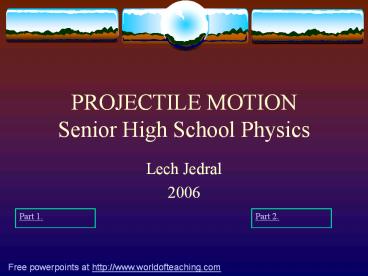PROJECTILE MOTION Senior High School Physics PowerPoint PPT Presentation
Title: PROJECTILE MOTION Senior High School Physics
1
PROJECTILE MOTIONSenior High School Physics
- Lech Jedral
- 2006
Part 1.
Part 2.
Free powerpoints at http//www.worldofteaching.com
2
Introduction
- Projectile Motion
- Motion through the air without a propulsion
- Examples
3
Part 1.Motion of Objects Projected Horizontally
4
y
v0
x
5
y
x
6
y
x
7
y
x
8
y
x
9
y
- Motion is accelerated
- Acceleration is constant, and downward
- a g -9.81m/s2
- The horizontal (x) component of velocity is
constant - The horizontal and vertical motions are
independent of each other, but they have a common
time
g -9.81m/s2
x
10
- ANALYSIS OF MOTION
- ASSUMPTIONS
- x-direction (horizontal) uniform motion
- y-direction (vertical) accelerated motion
- no air resistance
- QUESTIONS
- What is the trajectory?
- What is the total time of the motion?
- What is the horizontal range?
- What is the final velocity?
11
Frame of reference
Equations of motion
12
Trajectory
x v0 t
y h ½ g t2
Parabola, open down
Eliminate time, t
t x/v0 y h ½ g (x/v0)2 y h ½ (g/v02)
x2 y ½ (g/v02) x2 h
13
Total Time, ?t
?t tf - ti
y h ½ g t2
final y 0
0 h ½ g (?t)2
ti 0
Solve for ?t
tf ?t
Total time of motion depends only on the initial
height, h
14
Horizontal Range, ?x
x v0 t
final y 0, time is the total time ?t
?x v0 ?t
Horizontal range depends on the initial height,
h, and the initial velocity, v0
15
VELOCITY
vx v0
T
vy g t
16
FINAL VELOCITY
vx v0
T
vy g t
T is negative (below the horizontal line)
17
HORIZONTAL THROW - Summary
h initial height, v0 initial horizontal
velocity, g -9.81m/s2
18
Part 2.Motion of objects projected at an angle
19
Initial position x 0, y 0
20
y
a g - 9.81m/s2
- Motion is accelerated
- Acceleration is constant, and downward
- a g -9.81m/s2
- The horizontal (x) component of velocity is
constant - The horizontal and vertical motions are
independent of each other, but they have a common
time
x
21
- ANALYSIS OF MOTION
- ASSUMPTIONS
- x-direction (horizontal) uniform motion
- y-direction (vertical) accelerated motion
- no air resistance
- QUESTIONS
- What is the trajectory?
- What is the total time of the motion?
- What is the horizontal range?
- What is the maximum height?
- What is the final velocity?
22
Equations of motion
23
Equations of motion
24
Trajectory
x vi t cos T y vi t sin T ½ g t2
Parabola, open down
y
Eliminate time, t
t x/(vi cos T)
y bx ax2
x
25
Total Time, ?t
y vi t sin T ½ g t2
final height y 0, after time interval ?t
0 vi ?t sin T ½ g (?t)2
Solve for ?t
x
t 0 ?t
26
Horizontal Range, ?x
x vi t cos T
y
final y 0, time is the total time ?t
?x vi ?t cos T
x
0
?x
sin (2 T) 2 sin T cos T
27
Horizontal Range, ?x
- CONCLUSIONS
- Horizontal range is greatest for the throw angle
of 450 - Horizontal ranges are the same for angles T and
(900 T)
28
Trajectory and horizontal range
vi 25 m/s
29
Velocity
- Final speed initial speed (conservation of
energy) - Impact angle - launch angle (symmetry of
parabola)
30
Maximum Height
vy vi sin T g t
y vi t sin T ½ g t2
At maximum height vy 0
0 vi sin T g tup
tup ?t/2
31
Projectile Motion Final Equations
(0,0) initial position, vi vi T initial
velocity, g -9.81m/s2
2 vi sin T
(-g)
vi2 sin2 T
2(-g)
32
PROJECTILE MOTION - SUMMARY
- Projectile motion is motion with a constant
horizontal velocity combined with a constant
vertical acceleration - The projectile moves along a parabola

